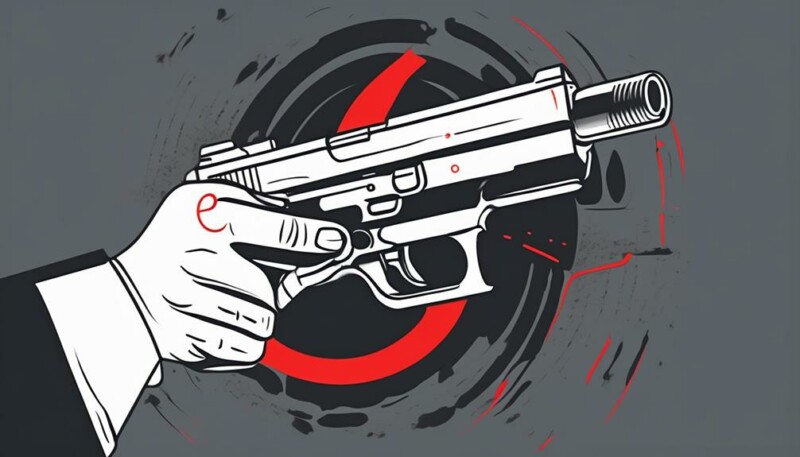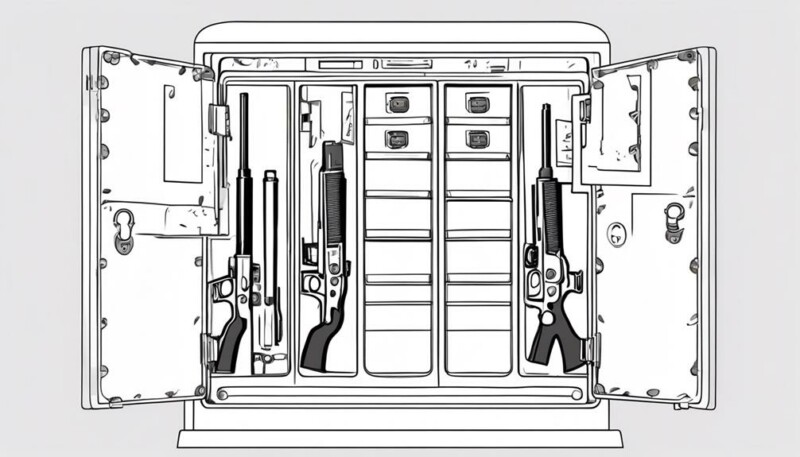Just as a seasoned captain navigates treacherous waters using a compass, you too must navigate the realm of firearm safety with a clear understanding of the seven key regulations.
These guidelines act as your compass, leading you away from potential accidents and ensuring you uphold the highest standards of safety and responsibility.
The first rule symbolizes a key principle, treating every firearm as if it's loaded. Yet, this is only the beginning, there's much more to explore.
Ready to set sail?
Key Takeaways
- Treat every firearm as if it's loaded, regardless of what you've been told
- Always point firearms in a safe direction to prevent injury if they unintentionally discharge
- Be conscious of your firearm's status and avoid carrying a firearm with a chambered cartridge when unnecessary
- Properly identify your target before taking any shot to avoid unintentional harm or damage
Recognizing Loaded Firearms

Understanding whether a firearm is loaded is crucial to your safety, so always treat every weapon as if it's loaded, regardless of what you've been told. This mindset of treating every firearm as loaded is a fundamental rule in firearm safety. It can potentially prevent accidents and injuries in case the firearm is, in fact, loaded.
You should never rely solely on someone else's word that a firearm is unloaded. Take full responsibility for your safety and that of others by always ensuring to check the chamber yourself. This practice can save lives, as it eliminates the risk of an accidental discharge, which could be fatal.
Recognizing loaded firearms is an essential part of safe firearm handling. This requires knowledge and a conscious effort to follow safety procedures, including never pointing a firearm at yourself or anyone else, irrespective of whether you believe it to be loaded or unloaded.
Guidelines for Safe Direction
When handling firearms, it's crucial to always point them in a direction that would prevent injury if they unintentionally discharge. This principle, a cornerstone of Firearms Safety, is known as maintaining a safe direction.
You must never point a firearm at anything you don't intend to shoot. This rule applies whether you're at home, at a shooting range, or in the field.
A safe direction means that even if the firearm were to discharge it wouldn't cause injury or damage. The key to this is understanding that a safe direction can change based on multiple factors. For instance, it could vary depending on where you are, who's around you, and the type of firearm you're handling.
Avoid pointing your firearm at hard surfaces or water. Bullets can ricochet unpredictably off these surfaces, causing unintended harm. Instead, choose a direction where an unintentional discharge won't cause injury or damage, like towards the ground or a specially designed backstop.
To effectively handle a firearm, always stay aware of your environment and adjust your safe direction accordingly. Never point a firearm thoughtlessly, remember, safety always comes first.
Timely Cartridge Chambering

Just as you're conscientious about maintaining a safe direction, it's equally vital to practice timely cartridge chambering, another fundamental aspect of firearm safety. This practice involves chambering a live cartridge into your firearm only when necessary. It's a key component of gun safety, ensuring responsible handling of firearms.
Here are three crucial points to bear in mind:
- Always be conscious of your firearm's status. Avoid carrying a firearm with a chambered cartridge when it's not necessary. This keeps you and those around you safe from accidental discharges.
- Adapt to changing situations. If you're leaving a hunting area or finishing a shooting session, return your firearm to its loaded state or fully unload it. This prevents mishandling or accidental discharges.
- Only chamber a cartridge when you're ready to fire. This means you should be in a position to shoot and have a clear target.
Target Identification Essentials
Understanding your target is crucial in firearm safety. We'll discuss techniques to correctly identify your target and ways to prevent misidentification mishaps.
Know Your Target
Before taking any shot, it's crucial to properly identify your target and understand what lies beyond it to ensure safety. This is a fundamental principle in the Rules of Firearms.
When you intend to shoot, you must:
- Clearly know your target. Use tools like binoculars to confirm the identity of your target and to avoid any potential accidents.
- Be aware of what's beyond the target. Bullets can travel a long distance, and you need to be certain there's no risk of unintentionally hitting someone or something.
- Never shoot if there's a risk involved. Safety should always be your priority.
Following these practices not only upholds safety regulations but also promotes responsible gun ownership.
Identification Techniques
Building on the crucial importance of knowing your target, let's explore some essential techniques for accurate target identification.
In all gun handling scenarios, it's paramount to positively identify your target before firing. This is a key safety precaution to prevent accidents. Use tools like binoculars to confirm your target's identity.
In addition, be conscious of what lies beyond your target, because firearms and ammunition can cause unintentional harm. Avoid shooting at sounds, movement, or unclear shapes. If there's any doubt about your target, don't take the shot.
These identification techniques, when properly applied, reduce risk and uphold safety in the use of firearms. Remember, in uncertainty, safety should always be the priority.
Avoiding Misidentification Mishaps
In the world of firearms, avoiding misidentification mishaps is crucial. Always make sure to positively identify your target before you shoot.
Some key essentials when handling firearms include:
- Never assume: Always verify your target, even if you think you're certain. Assumptions can lead to serious accidents.
- Check and double-check: Use tools like binoculars to confirm your target. Be aware of what lies beyond your target and consider the background before shooting.
- Use a gun case: Storing your firearm in a gun case can prevent accidental discharges and mishandling.
Importance of Firing Zone Check
Understanding the importance of firing zone checks is crucial to your firearm safety routine.
Always visually confirm your firing zone to reduce the risk of unintentional harm or damage.
Identifying Safe Firing Zones
Every time you handle a firearm, it's essential to identify a safe firing zone to prevent unintended harm and ensure the safety of those around you. This practice is a key aspect of safety when using firearms, and it should never be overlooked.
Here are three important steps to identifying safe firing zones:
- Understand Your Surroundings: Always be aware of what's beyond your target. Bullets can travel through or past it.
- Choose a Safe Direction: Aim your firearm in a direction where an accidental discharge won't cause injury or damage.
- Regularly Check the Zone: Conditions can change quickly. Regularly re-evaluate your firing zone to maintain safety.
Consequences of Negligence
Neglecting to perform a firing zone check can lead to severe consequences, potentially causing harm to yourself or others. This is a crucial part of understanding 7 key firearm safety regulations. When you've finished shooting, always unload the firearm and perform a thorough check.
Here's a quick guide to help you remember:
| Action | Result |
|---|---|
| Perform Firing Zone Check | Prevents Accidents |
| Neglect Firing Zone Check | Potential Harm |
| Unload the Firearm | Ensures Safety |
| Finished Shooting | Unload and Check |
| Understanding Safety Regulations | Avoid Consequences of Negligence |
Safe Firearm and Ammunition Storage

To ensure safety, you'll need to store your firearms and ammunition securely in lockable cases, cabinets, or safes, thus preventing unauthorized access. Understanding 7 key firearm safety regulations, including safe firearm and ammunition storage, is critical to preventing accidents and ensuring that every gun is handled responsibly.
- Store Safely: Always store your firearms and ammunition separately. This further reduces the risk of accidental discharge if an unauthorized person gains access.
- Educate Family Members: It's crucial to make sure to check that all family members, especially children, understand the importance of firearm safety. They should be aware that they must never access these items without permission.
- Follow Local Laws: Different regions have varying laws and regulations regarding firearm and ammunition storage. Complying with these isn't just a legal necessity, but often incorporates best practices for safety.
Incorporating these keys into your routine can significantly enhance the safety of your home and community. By adhering to safe firearm and ammunition storage principles, you help create an environment where firearms ownership is responsible, secure, and respectful of the potential dangers that can arise from negligence.
Avoiding Substances While Handling Firearms
When handling firearms, it's crucial that you avoid consuming any substances, such as alcohol, that could impair your judgment or coordination. Your ability to safely handle a gun is directly linked to your mental and physical state. Just as you wouldn't drive a car while under the influence, you shouldn't operate a firearm.
Even if you believe you're only "slightly" impaired, don't risk it. Dangers exponentially increase when handling firearms under the influence. Impaired judgment can lead to tragic accidents, affecting not just you, but potentially another person.
Consider this table to understand the gravity of substance impairment on firearm handling:
| Substance | Potential Impact |
|---|---|
| Alcohol | Impaired judgment, loss of coordination |
| Marijuana | Altered perception, poor motor control |
| Prescription Drugs | Drowsiness, slowed reaction time |
| Illicit Drugs | Unpredictable behavior, hallucinations |
| Over-the-counter Medication | Dizziness, drowsiness |
Adhering to these safety regulations is not just about you. It's about protecting everyone around you. Remember, 42 percent of firearm accidents are due to the influence of substances. So, always prioritize clear judgment and coordination by avoiding substances when handling a firearm. Safety first.
Frequently Asked Questions
What Is the 7th Commandment of Firearm Safety?
The 7th commandment of firearm safety is all about target awareness. It's important you know not just your target, but what's behind it too. Before you pull the trigger, positively identify your target. Ensure you have a clear view and know what's beyond it. This prevents accidental harm.
What Are the Basics of Firearms Safety?
You'd think firearm safety is rocket science, right? Nope, it's simple!
Always treat guns as loaded. Don't point them at anyone, including yourself.
Always aim in a safe direction, and avoid ricochet-prone surfaces. Only load when necessary, and always know your target.
Securely store your firearms and ammo, and always check for remaining ammo.
And hey, don't be shy about safety courses. It's all about keeping everyone safe, after all.
What Are the 5 Primary Rules of Firearm Safety?
You've asked about the 5 primary rules of firearm safety.
First, always treat all firearms as if they're loaded.
Second, never point a gun at anything you don't intend to shoot.
Third, only chamber a round when ready to fire.
Fourth, identify your target and what's beyond it.
Finally, only shoot when you're sure of your target.
These rules are vital to prevent accidents and ensure safe firearm handling.
What Are the 4 Golden Rules of Gun Safety?
You're asking about the 4 golden rules of gun safety. They're crucial to remember:
1) Always treat guns as if they're loaded.
2) Never point a gun at anything you don't intend to destroy.
3) Only place your finger on the trigger when ready to shoot.
4) Always confirm your target, and what's behind it.
These rules are fundamental in ensuring safety when handling firearms.
Conclusion
In wrapping up, always remember, 'an ounce of prevention is worth a pound of cure.'
Grasp these seven essential firearm safety rules firmly. Treat every gun as loaded, point safely, chamber cartridges wisely, identify targets, check firing zones, store securely, and verify age responsibly.
It's not just about owning a gun, it's about handling it responsibly. After all, safety first, because accidents last.
